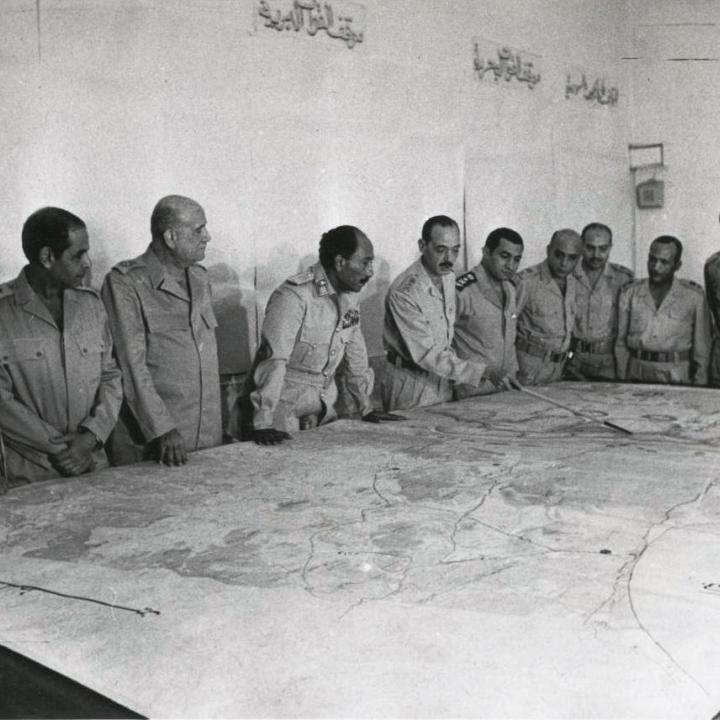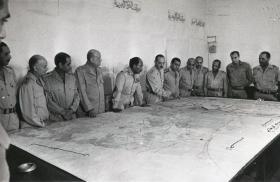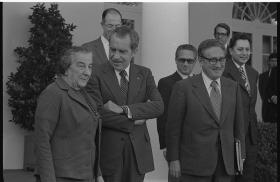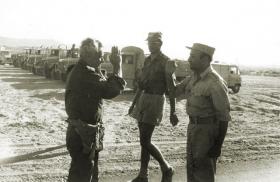
- Policy Analysis
- PolicyWatch 3792
Implications of the October War: From Warfighting to Peacemaking

Part of a series: The October 1973 War Redux
or see Part 1: The October 1973 War Redux: Lessons for Today’s Middle East Policy Challenges
In the opening panel of a special three-day anniversary event, experts and former officials from Egypt, Israel, and the United States discussed the conflict’s enduring lessons for peacemaking and statesmanship today.
On October 3, The Washington Institute held a virtual Policy Forum with Anwar E. El Sadat, David Makovsky, Efraim Halevy, Abdel Monem Said Aly, and Martin Indyk. Sadat is a former member of the Egyptian parliament and nephew of the late president Anwar Sadat. Makovsky is the Institute’s Ziegler Distinguished Fellow and director of its Koret Project on Arab-Israel Relations. Halevy is the former head of Mossad and former Israeli ambassador to the EU. Said Aly is director of the Regional Center for Strategic Studies in Cairo and a senior fellow at the Crown Center for Middle East Studies at Brandeis University. Indyk is the Lowy Distinguished Fellow at the Council on Foreign Relations and former U.S. ambassador to Israel. The following is a rapporteur’s summary of their remarks.
Anwar E. El Sadat
President Anwar Sadat was a devoted family man and farmer at his roots. When he assumed the presidency in 1970, Egypt was reeling from the defeat of 1967, and its national character was shattered. He faced extreme domestic pressure from the youth revolution to regain Egypt’s territory and fight back against Israel. Accordingly, he reorganized the army and moved to a small villa near military intelligence headquarters to be at the heart of decisionmaking.
As a scholar of history, Sadat knew conflict could not persist forever. In the interest of peace, he sent diplomatic messages to the United States and Europe in early 1973 to test the waters for negotiations. After Henry Kissinger overlooked these signals, Sadat felt he had no choice but to order military action against Israel. He knew his capabilities, but he also knew his limits—he was aware of Israel’s strength and initiated war with the assumption that Egypt’s forces could only push fifteen kilometers beyond the Suez Canal.
Sadat was a man who strived for peace, and 1973 was no different. Today, Egyptians remember him for his tactical leadership in the 1973 war, and people across the world regard him as a prophet for peace. Despite his shortcomings, Sadat was a visionary whose actions in 1973 remade the Middle East.
David Makovsky
In the lead-up to 1973, crucial miscalculations on all sides influenced the trajectory toward war and its attendant consequences. Prior to the conflict, U.S. leadership deeply underestimated Sadat. Kissinger missed important signals from Cairo, including its expulsion of Soviet advisors and warnings of impending war from Sadat’s national security advisor, Mohammed Hafez Ismail, during secret talks in February 1973.
On the Israeli side, Golda Meir and defense leaders downplayed the chances of war due to “konzeptzia,” the intelligence doctrine that stated Egypt would not engage in a war it was likely to lose. Warnings of imminent attack were ignored, deterring the Israel Defense Forces from mobilizing and contributing to heavy losses at the conflict’s outset. While Israel emerged victorious, public fury over intelligence and military failures swept Meir from power and accelerated the collapse of the Labor Party’s de facto rule, unbroken since 1948.
Sadat, for his part, was overconfident and squandered early gains by pushing further into the Sinai Peninsula and rejecting a ceasefire resolution. In the end, Israeli tanks were on the road to Cairo and Egypt’s Third Army was encircled without food or water.
However painful the war was for all parties, those nineteen days also shattered the regional order. Just six years after the ceasefire, Israel and Egypt signed a peace treaty under America’s aegis, heralding the end of Arab-Israel interstate warfare.
Efraim Halevy
After 1967, Israelis felt euphoric and found themselves in a uniquely strategic position. Yet they ignored two key elements in the lead-up to 1973: the Egyptian army’s growing capabilities, and unrest on the Israel-Egypt border. In the first week of war, Israel lost nearly 800 tanks to a large supply of Egyptian Soviet-supplied antitank missiles. It also neglected the mounting signals of war and allowed erroneous military assumptions to go unchallenged.
Once Israel encircled the Third Army, Meir told Kissinger that water could be delivered if Egypt agreed to direct talks between military officials on handling postwar disengagement and returning prisoners of war. Misreading Sadat, Kissinger argued that Egypt would never agree to direct negotiations. In light of this, Meir wrote a letter to a small group of officials, including myself, outlining her intent to resign after acceding to Kissinger’s demands to deliver water without negotiations. Yet we delayed the letter, and the next day the Egyptians agreed to direct talks. Meir reprimanded us for our disobedience but congratulated us on the result.
Peace efforts continued beyond 1973. In 1976, Prime Minister Yitzhak Rabin traveled secretly to Morocco to meet with his Egyptian counterpart; Prime Minister Moshe Dayan did the same in 1977. Against that backdrop, Sadat’s arrival in Jerusalem that year was unsurprising. Although peace has since prevailed, the remarkable Israeli intelligence failures of 1973 are worth bearing in mind.
Abdel Monem Said Aly
History teaches us that geography and demography decide conflicts. In the lead-up to 1973, U.S. intelligence was highly influenced by Israeli intelligence, so both parties misapprehended Sadat’s intentions. Sadat’s renovation of the Egyptian army was completely overlooked, as was his expulsion of Russian advisors.
Tactically, Sadat’s bargaining style was soft, but in substance he was a hardliner. He used Ashraf Marwan, an Egyptian double agent in Israel, to acquire confidential information from Israeli intelligence while keeping the IDF guessing. To launch a successful surprise attack, Egypt needed to deceive Israel at a pivotal moment, and Marwan’s role was key to this deceit; in the hours before the attack, he told the Israelis that war would begin at 6 pm, though the Egyptians planned to strike at 2. Those four hours were crucial to Egypt’s early gains in the Sinai.
More broadly, the war transformed the Arab-Israeli conflict from existential to non-existential. The signing of the Israel-Egypt peace treaty created legitimacy for broader peace, especially among Arab populations. The 1973 war was much more than an armed conflict—it was a projection of the current moment. Whether or not today’s brewing Israel-Saudi normalization deal reaches fruition, the 1973 war legitimized such efforts as a pathway, and the Egyptian people remember Sadat for his courageous and visionary role in that conflict.
Martin Indyk
Kissinger’s blind spot for Sadat was a failure of imagination. Prior to 1973, Kissinger had very limited exposure to Arab leaders and rarely traveled to the Middle East. Instead, the U.S. view of Sadat was heavily influenced by Israeli assessments, which deeply underestimated him. As Kissinger became distracted by other foreign affairs, he put Sadat and the signs of war on the back burner.
Once the conflict erupted, Kissinger was under intense pressure from President Nixon to position the United States as the indispensable peace broker under negotiating terms favorable to Washington. To accomplish this, Kissinger needed to ensure a limited Israeli victory to preserve the possibility for Egypt to enter negotiations. After successfully juggling these contradictory pressures, he constructed a new political order in the Middle East and averted a superpower confrontation with the Soviets.
The war also birthed Kissinger’s gradualist approach. He understood that the Arab-Israeli conflict could not be resolved in one step, and future leaders (e.g., Rabin) adopted this strategy in negotiations with the Palestinians. Yet Kissinger’s gradualism had a crucial drawback: it encouraged many leaders to err on the side of caution rather than ambition. Focusing too much on incrementalism can miss opportunities for peace, especially when both sides are prepared for change. Kissinger and the 1973 war reflect the stark challenges of statesmanship and the extraordinary possibilities of diplomacy.
This summary was prepared by Sydney Hilbush.








